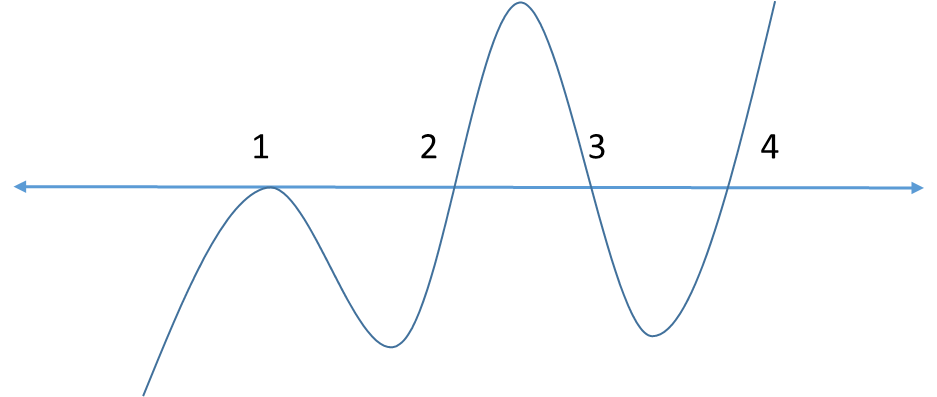Just came across this useful discussion.
VeritasPrepKarishma has given a very lucid explanation of how this “wavy line” method works.

I have noticed that there is still a little scope to take this discussion further. So here are my two cents on it.
I would like to highlight an important special case in the application of the Wavy Line Method
When there are multiple instances of the same root:Try to solve the following inequality using the Wavy Line Method:
\((x-1)^2(x-2)(x-3)(x-4)^3 < 0\)
To know how you did, compare your wavy line with the correct one below.
Did you notice how this inequality differs from all the examples above?
Notice that two of the four terms had an integral power greater than 1.
How to draw the wavy line for such expressions?Let me directly show you how the wavy line would look and then later on the rule behind drawing it.
Attachment:
File comment: Observe how the wave bounces back at x = 1.
 bounce.png [ 10.4 KiB | Viewed 15139 times ]
bounce.png [ 10.4 KiB | Viewed 15139 times ]
Notice that the curve bounced down at the point x = 1. (At every other root, including x = 4 whose power was 3, it was simply passing through them.)
Can you figure out why the wavy line looks like this for this particular inequality?
(Hint: The wavy line for the inequality
\((x-1)^{38}(x-2)^{57}(x-3)^{15}(x-4)^{27} < 0\)
Is also the same as above)
Come on! Give it a try.

If you got it right, you’ll see that there are essentially only two rules while drawing a wavy line. (Remember, we’ll refer the region above the number line as positive region and the region below the number line as negative region.)
How to draw the wavy line?1.
How to start: Start from the top right most portion. Be ready to alternate (or not alternate) the region of the wave based on how many times a point is root to the given expression.
2.
How to alternate: In the given expression, if the power of a term is odd, then the wave simply passes through the corresponding point (root) into the other region (to –ve region if the wave is currently in the positive region and to the +ve region if the wave is currently in the negative region). However, if the power of a term is even, then the wave bounces back into the same region.
Now look back at the above expression and analyze your wavy line. Were you (intuitively) using the above mentioned rules while drawing your wavy line?
 Solution
SolutionOnce you get your wavy line right, solving an inequality becomes very easy. For instance, for the above inequality, since we need to look for the space where the above expression would be less than zero, look for the areas in the wavy line where the curve is below the number line.
So the correct solution set would simply be {3 < x < 4} U {{x < 2} – {1}}
In words, it is the
Union of two regions –
region1 between x = 3 and x = 4 and
region2 which is
x < 2, excluding the point x = 1.
Food for ThoughtNow, try to answer the following questions:
1. Why did we exclude the point x = 1 from the solution set of the last example? (Easy Question)
2. Why do the above mentioned rules (especially rule #2) work? What is/are the principle(s) working behind the curtains?
Foot Note: Although the post is meant to deal with inequality expressions containing multiple roots,
the above rules to draw the wavy line are generic and are applicable in all cases.

- Krishna



